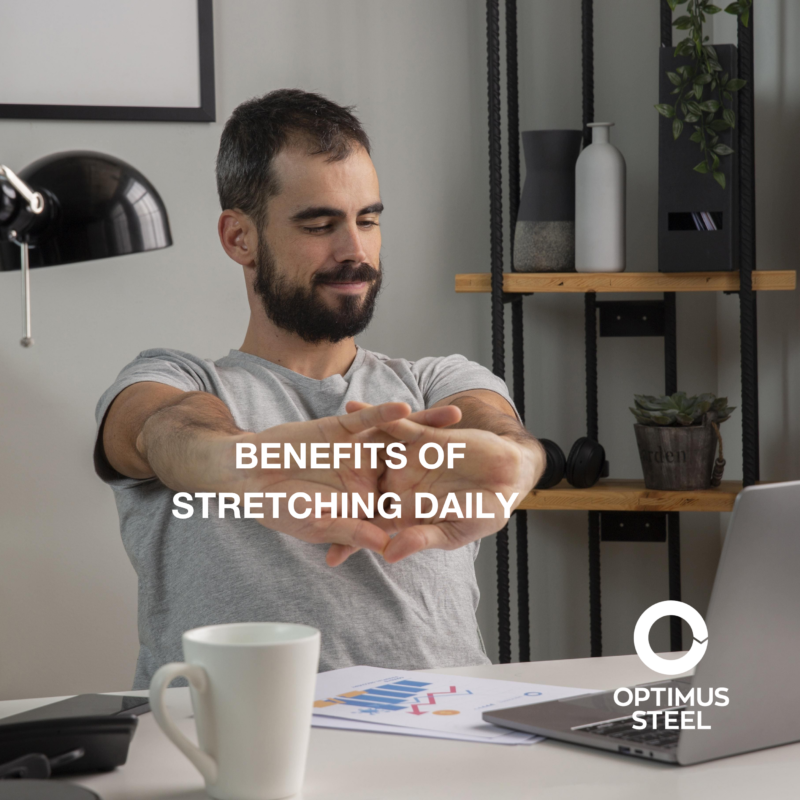
Stretching is a simple, effective way to support both physical and mental health, especially if you spend long hours sitting or performing repetitive tasks. The benefits of daily stretching apply to everyone, from office employees to industrial workers.
- Improved Flexibility and Range of Motion
Regular stretching enhances muscle and tendon elasticity, improving your overall range of motion. Even a single stretching session can lead to measurable gains in flexibility. Static stretching, in particular, is a safe and effective method to enhance flexibility, physical function, and overall quality of life—with minimal risk. - Reduced Muscular Stiffness and Tension
Stretching helps relieve muscle stiffness by influencing neuromuscular reflexes and directly reducing pain and tension—providing up to 94% relief in cases involving trigger point discomfort. - Relief from Back Pain and Postural Discomfort
Workplace stretching programs have been shown to significantly reduce musculoskeletal complaints in the neck, shoulders, and back after just three months of consistent practice. Regular stretch breaks also reduce discomfort among office and warehouse workers. - Enhanced Circulation and Muscle Oxygenation
Stretching activates the “muscle pump,” which improves blood flow and venous return. This helps deliver oxygen and nutrients to tissues while removing metabolic waste, keeping muscles healthy and energized. - Stress Regulation and Mental Well-Being
Short stretching routines have been shown to have positive effects on anxiety, fatigue, and mood. For example, a stretching session can enhance relaxation and cognitive performance. Workplace stretching programs have also been linked to significant reductions in perceived stress and notable improvements in mental health after 12 weeks of consistent participation. - Better Sleep Quality
Stretching combined with light exercise has been associated with improved sleep efficiency, longer sleep duration, and a shorter time to fall asleep—particularly in individuals with chronic insomnia or elevated stress levels. - Maintaining Strength and Functional Ability Just 10 minutes of daily stretching can help counteract declines in strength, flexibility, and functional performance during periods of inactivity. A six-week stretching program for individuals with chronic pain reduced pain sensitivity and improved range of motion, with benefits lasting for several weeks after completion.
Importance of Physical Activity in the Workplace
Regular movement throughout the workday is just as important as stretching. Incorporating short bouts of activity helps maintain energy, productivity, and well-being.
- Counteracts sedentary behavior: Active breaks reduce stiffness, poor circulation, and metabolic risks associated with prolonged sitting.
- Enhances well-being and reduces fatigue: Frequent movement decreases sleepiness, stress, and muscle discomfort.
- Boosts productivity and focus: Well-timed breaks improve concentration and energy levels.
- Reduces absenteeism: Workplace wellness programs that encourage physical activity have been linked to fewer sick days and improved morale.
- Prevents musculoskeletal disorders (MSDs): Stretching, mobility, and strengthening exercises help reduce repetitive strain and posture-related issues.
- Improves cognitive function: Even 5–10 minutes of light movement can boost memory, attention, and problem-solving.
How to Incorporate Stretching and Active Breaks at Work
- Take short active breaks.
Spend 2–5 minutes moving or stretching to prevent stiffness. Try overhead reaches, trunk rotations, or neck and shoulder rolls. - Schedule structured routines.
Plan a short session in the morning or after lunch that includes: - Join guided active pauses.
Instructor-led sessions—onsite or virtual—encourage consistency, improve mood, and reduce musculoskeletal pain. - Incorporate movement into daily tasks.
- Walk around during phone calls if using a handsfree device as there are less distractions.
- Stand when you can for tasks you may normally sit for, like a conference call.
- Add mini squats or calf raises between tasks
5. Combine posture and visual breaks.
Adjust your workstation setup and give your eyes a rest—look 20 feet away for 20 seconds every 20 minutes (the “20-20-20 rule”).
6. Provide training and awareness.
Teach employees proper stretching techniques: hold positions steadily, avoid bouncing, and stay within comfortable limits.
Conclusion
Incorporating stretching and movement into the workday is a low-cost, high-impact strategy for improving health, mood, and performance. Multiple workplace studies demonstrate benefits for musculoskeletal pain, flexibility, mental well-being, and concentration.
While stretching alone isn’t a guaranteed method for preventing injuries, it remains a vital part of a holistic approach that includes ergonomics, strength training, and regular physical activity. For organizations, promoting structured stretch breaks and active movement fosters a healthier, more focused, and more productive workforce.
